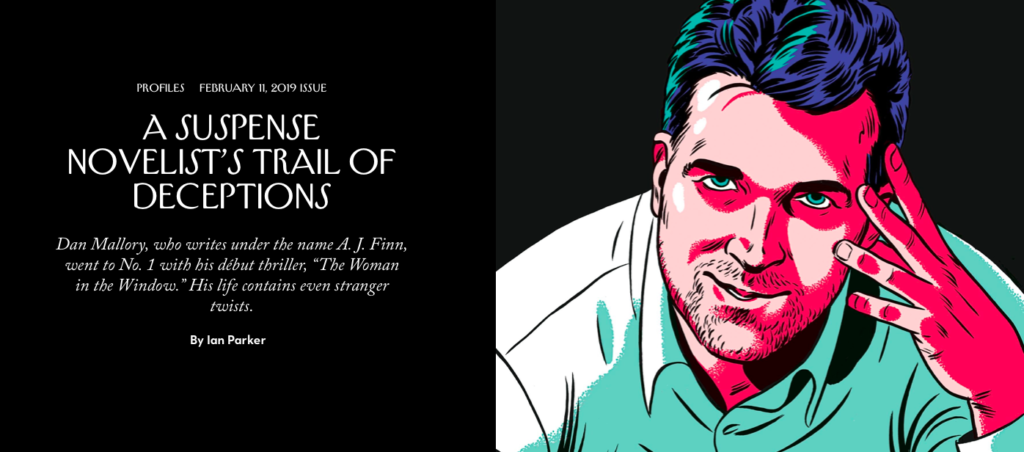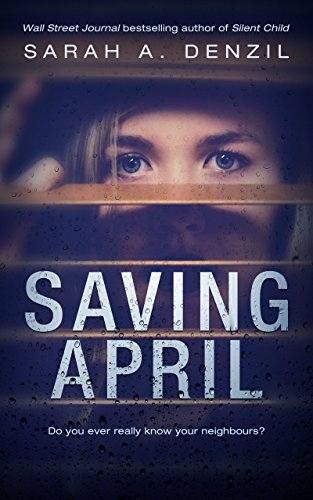
Who needs reminding that A.J. Finn is the author wunderkind whose debut novel The Woman in the Window catapulted to the #1 spot in the bestseller lists the week it was published in January 2018?
Who needs reminding — or maybe didn’t know, or hasn’t heard — that The New Yorker magazine (pictured) recently exposed A.J. Finn (real name Dan Mallory) as a con artist and liar? The magazine published the 12,000 word article, A Suspense Novelist’s Trail of Deceptions, about Mallory last month.
Amazing Con Job
In it, journalist Ian Parker revealed that Mallory had lied to and duped his colleagues at William Morrow, where he worked as an editor (yes, for the same publisher who published his thriller) ) and at other publishing houses where he worked in the U.K. and in New York.
Among other lies, he spun stories about suffering with an inoperable brain tumor, about having surgery on a spinal tumor, about the deaths of his mother from cancer, and brother Jake by suicide, and about receiving two doctorate degrees, one from Oxford University. He also lied on a job application saying he’d held a job as an editor when he had worked as an assistant.
The article also revealed that after returning from London where he was an editor at Little, Brown, he faked a British accent and continued to use Britishisms like “bloody” and “brilliant,” and “loo” (for bathroom.)
According to many people contacted by Parker, Mallory “had a history of imposture, and duping people with false stories of disease and death.” The New Yorker quotes one former Mallory colleague whom Parker contacted as responding with a laugh: “I knew I’d get this call. I didn’t know if it would be you or the FBI.”
A.J. Finn Apologizes (Sort Of)
After the publication of The New Yorker article, Finn/Mallory subsequently offered a statement in which he apologized for his deceptions, but said he thought it was better for people to think he had physical health issues rather than mental ones. He admitted to mental health issues after the publication of his novel. In fact, he said he’d used the experience of his depression and bipolar disorder to create his female protagonist, an agoraphobic drunk and pill abuser.
None of which actually explained how that justified lying about two doctorate degrees. Nor did it acknowledge that lying about health issues had allowed him to take huge chunks of sick leave from his $200,000 a year editorial position — leave, which he apparently used to write his debut novel.
As The New Yorker more astutely observed: he “lied to get attention, advancement, or to explain away his failures.”
Unanswered Questions

As lengthy and detailed as The New Yorker article is, it nevertheless still leaves some unanswered questions about A.J. Finn a.k.a Dan Mallory. I touched on a couple of them last year in two blogs I posted about the incredible success of The Woman in the Window.
Mysterious Connection to Powerful Agent
In the first blog, I tried to satisfy my curiosity as to how a debut novel by an unknown author had catapulted to the top of the bestseller lists in its first week of publication. One of the factors in its favor, of course, was Dan Mallory’s friendship with powerhouse literary agent, Jennifer Joel of the top talent agency, ICM.
Joel sent Finn’s manuscript to about eight major publishing houses. At the end of WITW, Finn/Mallory’s first line under Acknowledgments, reads : “Jennifer Joel, my friend, agent, and invaluable guide;”
However, Joel does not list A.J. Finn or Dan Mallory as one of her clients in the publishing world’s bible, Publishers Marketplace. Nor is her fabulous two-book, $2 million deal for Finn/ Mallory listed under her deals.
Publishers Marketplace informs its subscribers of all publishing deals, that is, who bought what book from whom, and what the book is about. Joel’s famous clients as per PM, going back to 2004, include: Nelson DeMille, Michael Crichton, Shonda Rhimes, Billy Crystal.
But there is no mention of A.J. Finn, Dan Mallory, The Woman In The Window or the two-book, $2 million deal in any search of Jennifer Joel’s name in the publishing industry bible.
I don’t get it.
Who Knew What, When?
One of the most intriguing and undisputed snippets in The New Yorker article is this one: “In 2016 midway through the auction for WITW, the author’s real name was revealed to bidders. At that point, most publishing houses dropped out. This move reflected an industry-wide unease with Mallory that never became public.”
It’s intriguing because the official press release in October 2016 from William Morrow and Harper Collins (the U.K. publishing house in the deal) on the acquisition of WITW stated:
“The manuscript was submitted under the pseudonym A.J. Finn and in a twist of Hitchcockian proportions, the Morrow editorial, marketing and publicity teams read and made an offer on the book before being informed the author was their colleague.”
I realize that the publishers’ press release doesn’t totally negate the snippet in The New Yorker. Yes, William Morrow could have made a first offer in the bidding before discovering A.J. Finn’s true identity.
However, an article in the New York Times in January 2018, when WITW was published, turns the waters murkier. The article states: “even William Morrow’s acquiring editor didn’t know the author’s identity (until) she pitched it to William Morrow publisher Liate Stehlik (and) learned it had been written by their own colleague.”
In which case, it would seem that William Morrow did know A.J. Finn’s true identity before making any sort of offer. If so, why make such a big deal in the press release about not knowing? Why perpetuate that myth in all the pre-publication hoopla?
I don’t get it.
Copycat?
 As is so often the case, a big expose sets journalists in other media on investigations of their own into the same subject. And, sure enough, a couple of weeks ago, the New York Times came up with a new angle on A.J. Finn : the possibility that he had plagiarized the work of others. The article, Similarities in 2 Novels Raises Questions compared WITW with a thriller, Saving April written by British author, Sarah A. Denzil. That novel was published by Amazon in January 2016 — two years before WITW. Comparisons were also subsequently made to the 1995 Sigourney Weaver movie, Copycat in which Sigourney plays a therapist who becomes agoraphobic and like the protagonist in WITW goes online and unknowingly interacts with her stalker.
As is so often the case, a big expose sets journalists in other media on investigations of their own into the same subject. And, sure enough, a couple of weeks ago, the New York Times came up with a new angle on A.J. Finn : the possibility that he had plagiarized the work of others. The article, Similarities in 2 Novels Raises Questions compared WITW with a thriller, Saving April written by British author, Sarah A. Denzil. That novel was published by Amazon in January 2016 — two years before WITW. Comparisons were also subsequently made to the 1995 Sigourney Weaver movie, Copycat in which Sigourney plays a therapist who becomes agoraphobic and like the protagonist in WITW goes online and unknowingly interacts with her stalker.
The NYT published an update after being shown Finn/Mallory’s outlines which agent, Jennifer Joel stated he had submitted to her in September and October 2015 — a couple of months before Denzil completed her novel and published it online in January 2016 as part of the Kindle Scout program.
So, it would appear the similar characters, and almost identical plot points are a massive coincidence. But given the following similarities, I just don’t get it.
Spoiler Alert!
 Both novels are about female agoraphobics who drink too much because of marital infidelity which led to the deaths of their spouses. Both novels’ protagonists believe they’ve witnessed a crime, but the cops don’t believe them. Both feature a teenage antagonist who is adopted, who is cruel to animals and who tries to kill the protagonist. And, take a look at the book covers !!!!!
Both novels are about female agoraphobics who drink too much because of marital infidelity which led to the deaths of their spouses. Both novels’ protagonists believe they’ve witnessed a crime, but the cops don’t believe them. Both feature a teenage antagonist who is adopted, who is cruel to animals and who tries to kill the protagonist. And, take a look at the book covers !!!!!
A.J. Finn Thriller #2
Oh yes, there’s going to be a second thriller, and William Morrow will publish it as I’m sure it’s contractually bound to do. I’m also sure that the reviews will be less rapturous than the ecstatic reviews for WITW — and certainly the book will be more closely scrutinized than the debut novel.
A.J. Finn has said that thriller #2 will be about a female thriller writer and an interviewer who learns of her dark past. Hmmmm!
In my opinion, this will surely encourage reviewers, if not book bloggers, to make the comparison to Dan Mallory’s own unsavory, dark past of lies and fabrications, and thus will be an opportunity to regurgitate all the most salacious highlights of The New Yorker article.
We’ll see.
Photo Credit for A.J. Finn photo: Alejandro Garcia